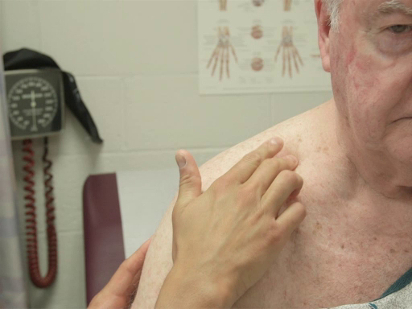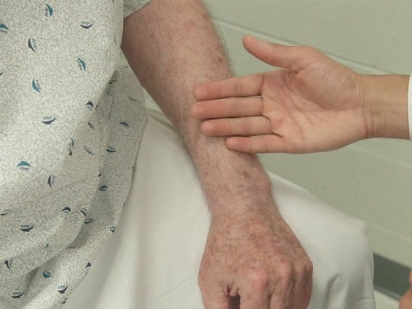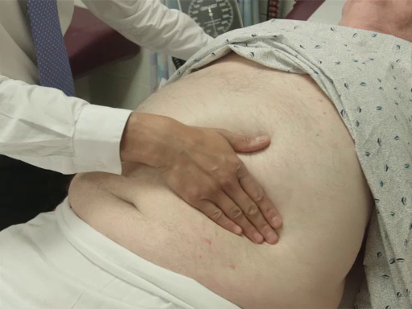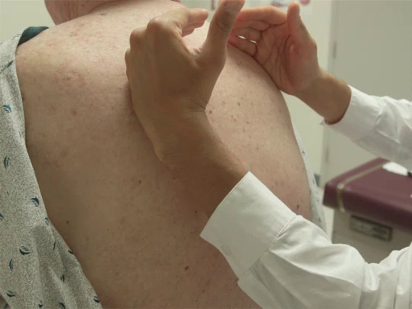触诊
English
소셜에 공유하기
개요
来源:Jaideep S.Talwalkar,MD、 内科、 儿科,耶鲁大学医学院,纽黑文,康涅狄格
体格检查要求所有供应商的感官来获取有关病人信息的使用。触觉被利用获得通过触诊诊断信息。
考官的手用于触诊的具体部位不同基于宗正的身体部分。因为他们密集的感觉神经支配,手指垫可用于细歧视 (例如,定义边界的肿块,淋巴结) (图 1)。背表面的手提供粗略的感觉相对温度 (图 2)。手和手指掌面被广泛用于测量大面积的身体 (例如,腹部) (图 3)。振动最好的赞赏与尺侧表面的手和 5th手指 (例如,触觉颤振) (图 4)。
触诊时基本物理考试的诊断方面,它也是重要的是承认触摸的作用过程中发挥了沟通关怀和安慰病人的遭遇。通常,病人认为触摸从正面的角度,医疗服务提供者和他们的医疗服务提供者的看法可以在临床的邂逅中由触摸熟练使用。1身体接触已与荷尔蒙的改变和神经递质水平、 专门的皮质醇降低和增加血清素。2
因此,通过小心使用触诊和触摸一般情况下,在体检,临床医师有机会获得重要的诊断信息,同时发展友好关系,促进愈合。

图 1。用手指垫的淋巴结检查。

图 2。使用手背,以评估为温暖。

图 3。与指掌侧表面的手指和手的腹部触诊。

图 4。使用手的尺侧表面以评估为触觉颤振。
Procedure
Applications and Summary
This demonstration covered the general considerations related to palpation during the physical examination. While specific techniques vary based on each individual portion of the exam, many general principles related to palpation hold throughout the exam. Attention to patient safety and comfort is achieved through hand-washing, proper grooming, warming of the hands, infection control precautions, and sensitive draping. The correct part of the fingers and hands should be used for different types of palpation, with finger pads being used most commonly during the exam. The clinician should be deliberate about the amount and duration of pressure being applied during palpation; these variables change based on the part of the body being examined and specific patient circumstances. Finally, the clinician should remember the important role that touch plays in the patient encounter in terms of therapeutic value and the clinician-patient relationship. The most direct physical contact during the encounter occurs through palpation, which provides an opportunity to secure the bond the clinician has started to develop during history taking.
References
- McCann, K., McKenna, H.P. An examination of touch between nurses and elderly patients in a continuing care setting in Northern Ireland. Journal of Advanced Nursing. 18, 838-46 (1993).
- Field, T. Violence and touch deprivation in adolescents. Adolescence. 37 (148), 735-749 (2002).
- Verrees, M. Touch me. JAMA. 276 (16), 1285-1286 (1996).
내레이션 대본
During a physical exam, the clinician uses the sense of touch through palpation to obtain useful diagnostic information. It is an assessment technique in which the examiner uses the surface of the fingers and hands to feel and examine an organ or body part. While palpation is fundamental to the diagnostic aspect of the physical exam, it is also important to acknowledge the role that touch plays in communicating caring and comfort during the patient encounter.
This video will illustrate the different palpation techniques, and discuss the approach and considerations for this procedure.
First, let’s discuss the different types of palpation techniques that are based on the specific parts of the examiner’s hand used to perform the procedure. Finger pads are used for palpation of most of the body parts. Because of their dense sensory innervation, the finger pads are useful for fine discrimination, for example defining the borders of masses, or while examining the lymph nodes. Fingertips are used for palpating specific structures like the nailbeds, liver edge, and cervix. In addition to fingertips and finger pads, physicians also use the ulnar surface of the hands and fifth fingers to appreciate vibration when performing specialized test like tactile fremitus. One should use the palmar surface of the fingers and hands for assessing functions like chest expansion, palpation of the precordium, light and deep abdominal palpation, and muscle strength testing. Lastly, the dorsal surface of the hands is used for getting rough sense of relative temperature, typically in comparison to another portion of the patient’s body.
Now that you know about different palpation techniques, let’s discuss the general approach to palpation during any clinical exam.
Before every patient encounter, make sure that your fingernails are clean, groomed, and trimmed. Wash your hands with soap and water or apply topical disinfectant solution. Warm your hands either with warm water or by rubbing them together. If any specific infection control precautions are needed, then wear the protective equipment and explain to the patient why it’s necessary. Remember: gowns, gloves, and masks can present a barrier to building a relationship with the patient.
In order to gauge the patient’s comfort with the clinician’s touch, you may start the examination with the hands. First, perform palpation of the nailbeds with your fingertips to assess for capillary refill and pallor. Then, palpate the radial pulse with your finger pads. After that, move to the anatomic region of interest, in this case the abdominal region. Employ draping techniques to optimize access, while balancing patient’s modesty. Next, ask the patient to point to the area of discomfort. Consider palpating it towards the end, making it clear to patients this is done in the interest of their comfort, “I’m going to examine this area last in order just to make it more comfortable for you.”
In general, be aware of the pressure used for palpation, which varies based on the structures being examined. For example, insufficient pressure may limit one’s ability to palpate deep structures, and excessive pressure may occlude a pulse, causing discomfort and limiting utility. Be deliberate about the palpation duration as well, which again differs based on the structure under examination. For example, while examining the lower extremities, the palpation needs to be performed for sufficient amount of time to reveal pitting edema, if present. This kind of information can be missed if palpation duration is insufficient. In addition, express empathy while acknowledging that examination of certain parts may cause the patient discomfort. Although patient expects to be examined, always ask permission and provide a warning if you are about to do something that may worsen the pain. At the end of the exam, drape the patient back and thank them for their cooperation.
You’ve just watched JoVE’s introduction to palpation. This demonstration covered the types and general considerations related to palpation during a physical exam. Through the careful use of this technique, the clinician has the opportunity to gain important diagnostic information, while developing rapport and promoting healing. As always, thanks for watching!
